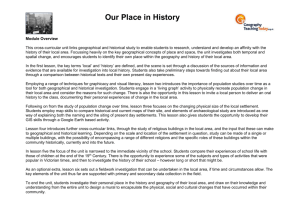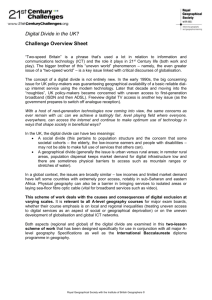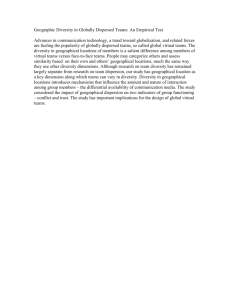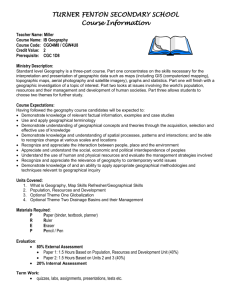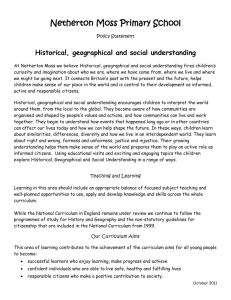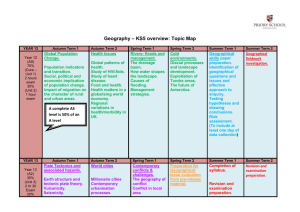- Royal Geographical Society
advertisement
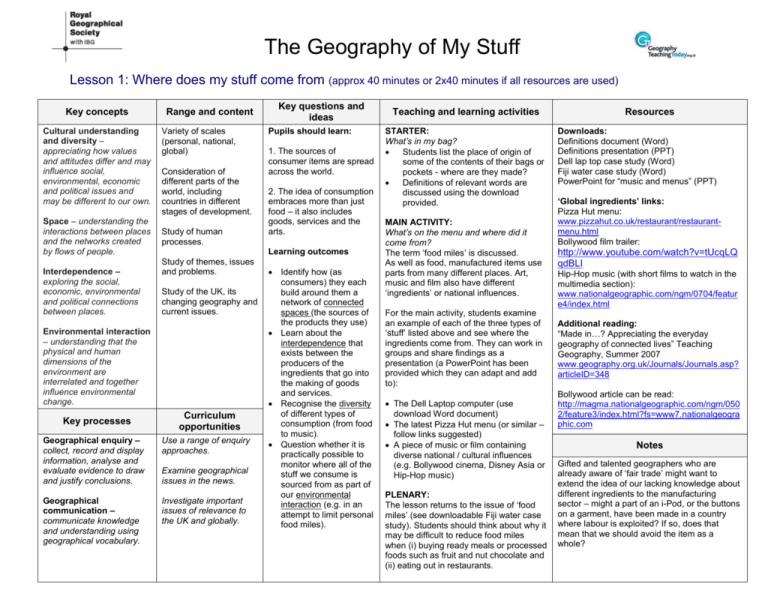
The Geography of My Stuff Lesson 1: Where does my stuff come from (approx 40 minutes or 2x40 minutes if all resources are used) Key concepts Cultural understanding and diversity – appreciating how values and attitudes differ and may influence social, environmental, economic and political issues and may be different to our own. Space – understanding the interactions between places and the networks created by flows of people. Interdependence – exploring the social, economic, environmental and political connections between places. Range and content Variety of scales (personal, national, global) Consideration of different parts of the world, including countries in different stages of development. Study of human processes. Pupils should learn: 1. The sources of consumer items are spread across the world. 2. The idea of consumption embraces more than just food – it also includes goods, services and the arts. Learning outcomes Study of themes, issues and problems. Study of the UK, its changing geography and current issues. Environmental interaction – understanding that the physical and human dimensions of the environment are interrelated and together influence environmental change. Key processes Key questions and ideas Curriculum opportunities Geographical enquiry – collect, record and display information, analyse and evaluate evidence to draw and justify conclusions. Use a range of enquiry approaches. Geographical communication – communicate knowledge and understanding using geographical vocabulary. Investigate important issues of relevance to the UK and globally. Examine geographical issues in the news. Identify how (as consumers) they each build around them a network of connected spaces (the sources of the products they use) Learn about the interdependence that exists between the producers of the ingredients that go into the making of goods and services. Recognise the diversity of different types of consumption (from food to music). Question whether it is practically possible to monitor where all of the stuff we consume is sourced from as part of our environmental interaction (e.g. in an attempt to limit personal food miles). Teaching and learning activities STARTER: What’s in my bag? Students list the place of origin of some of the contents of their bags or pockets - where are they made? Definitions of relevant words are discussed using the download provided. MAIN ACTIVITY: What’s on the menu and where did it come from? The term ‘food miles’ is discussed. As well as food, manufactured items use parts from many different places. Art, music and film also have different ‘ingredients’ or national influences. For the main activity, students examine an example of each of the three types of ‘stuff’ listed above and see where the ingredients come from. They can work in groups and share findings as a presentation (a PowerPoint has been provided which they can adapt and add to): The Dell Laptop computer (use download Word document) The latest Pizza Hut menu (or similar – follow links suggested) A piece of music or film containing diverse national / cultural influences (e.g. Bollywood cinema, Disney Asia or Hip-Hop music) PLENARY: The lesson returns to the issue of ‘food miles’ (see downloadable Fiji water case study). Students should think about why it may be difficult to reduce food miles when (i) buying ready meals or processed foods such as fruit and nut chocolate and (ii) eating out in restaurants. Resources Downloads: Definitions document (Word) Definitions presentation (PPT) Dell lap top case study (Word) Fiji water case study (Word) PowerPoint for “music and menus” (PPT) ‘Global ingredients’ links: Pizza Hut menu: www.pizzahut.co.uk/restaurant/restaurantmenu.html Bollywood film trailer: http://www.youtube.com/watch?v=tUcqLQ qdBLI Hip-Hop music (with short films to watch in the multimedia section): www.nationalgeographic.com/ngm/0704/featur e4/index.html Additional reading: “Made in…? Appreciating the everyday geography of connected lives” Teaching Geography, Summer 2007 www.geography.org.uk/Journals/Journals.asp? articleID=348 Bollywood article can be read: http://magma.nationalgeographic.com/ngm/050 2/feature3/index.html?fs=www7.nationalgeogra phic.com Notes Gifted and talented geographers who are already aware of ‘fair trade’ might want to extend the idea of our lacking knowledge about different ingredients to the manufacturing sector – might a part of an i-Pod, or the buttons on a garment, have been made in a country where labour is exploited? If so, does that mean that we should avoid the item as a whole? The Geography of My Stuff Lesson 2: Why can people buy more stuff than they used to? (approx. 40 minutes) Key concepts Place – geographical imaginations. Human processes – understanding how sequences of events and activities in the human world lead to change in places and societies. Cultural understanding and diversity – appreciating how values and attitudes differ and may influence social, environmental, economic and political issues and may be different to our own. Range and content Variety of scales (personal, national, global) Consideration of different parts of the world, including countries in different stages of development. Study of the UK, its changing geography and current issues. Study of human processes. Key questions and ideas Pupils should learn: 1. Societies are continually changing and the average level of wealth in the UK has grown considerably over time. 2. Much of this wealth is now spent on consumer goods and leisure time pursuits (especially for teenagers!) Learning outcomes: Study of themes, issues and problems. Key processes Geographical enquiry – analyse and evaluate evidence, presenting findings to draw and justify conclusions. Geographical enquiry – ask geographical questions, thinking critically, constructively and creatively. Curriculum opportunities Make links between geography and work in other subjects and areas of the curriculum. Use a range of enquiry approaches. Investigate important issues of relevance to the UK and globally. Learn about the changing processes taking place in UK society since the 1800s, allowing more people to become consumers. Recognise that teenagers today are, on average, better off than those who used to live in the same place until relatively recently. Question whether they are exercising free will as consumers of goods or where there is a degree of coercion thanks to global media, advertising and peer pressure. Teaching and learning activities Resources STARTER: Global patterns of pocket-money How do personal allowances vary between different countries and groups of people? Students match ten figures with the places shown. Why do they differ? Interactives: Pocket money patterns Teenage timeline MAIN ACTIVITY: Why are people in Britain buying more stuff than in the past? Of course, more ‘must-have’ items have been invented as each decade has passed. But students also need to be taught how: 1. Average incomes have risen. To show how life has changed, re-visit a 19th/early 20th Century story (e.g. a film extract from Oliver Twist) and observe the level of relative poverty compared with today. What work did people do? How were they paid? How do things differ today? What impact does this have on shopping and spending money? 2. Prices have fallen for many items. Show timeline of falling prices for some key products, such as TVs and CDs. Emphasise the changes in the geography of production (the shift to overseas manufacturing e.g. the Tiger economies and cheaper production as technology has improved) that have helped this to happen. Download the Teenage timeline to help students appreciate just how much more teenagers consume than in the past. Links: Online history of teenage fashion at: www.fashionera.com/1950s/1950s_4_teenagers_tedd y_boys.htm PLENARY: The lesson ends with a summary of the key factors that explain changing patterns of consumption: changing wealth (incomes), cheaper goods (overseas workers), better technology (new inventions), advertising. Which is most important? Gifted and talented geographers will be quick to point out that not all teenagers in the UK can afford all the items that are discussed during the lesson, and they are right to do so. Downloads: Falling costs of stuff (PPT) Video: Film extracts showing Victorian poverty: Oliver Twist (BBC) www.bbc.co.uk/drama/oliver/ Printed resources: School English departments may be able to provide sets of a suitable novel such as Oliver Twist which stresses the common-place nature of poverty in relatively recent past times. Teachers should identify a suitable extract for students to read. This is a good opportunity for inter-department cooperation. Notes The Geography of My Stuff Lesson 3: Where do we go to buy our stuff? (approx. 40 minutes, may extend to 2x 40 minutes or develop through fieldwork) Key concepts Scale – appreciating different scales and making links between them. Human processes – understanding how sequences of events and activities in the human world lead to change in places and societies. Interdependence – exploring the social, economic, environmental and political connections between places. Environmental interaction – understanding that the physical and human dimensions of the environment are interrelated and together influence environmental change. Range and content Variety of scales (personal, national, global) Consideration of different parts of the world, including countries in different stages of development. Study of the UK, its changing geography and current issues. Study of human processes. Study of themes, issues and problems. Investigation of peopleenvironment interactions. Place – geographical imaginations. Key processes Graphicacy and visual literacy - construct maps and plans at a variety of scales, using graphical techniques to present evidence; use of information generated by geographical information systems. Fieldwork and out of classroom learning – select and use fieldwork techniques appropriately, safely and efficiently. Curriculum opportunities Use varied resources, including maps and visual media. Use a range of enquiry approaches. Investigate important issues of relevance to the UK and globally. Undertake fieldwork investigations in different locations outside the classroom. Key questions and ideas Pupils should learn: 1. How and why different types of retail land use exist. 2. That these sites of consumption bring a range of social and environmental impacts. Learning outcomes: identify how the scale of sites of consumption may vary recognise that these sites have changed over time further develop an understanding of how consumption is responsible for interdependence (by examining the global supply networks that retailers use) develop graphical skills through drawing a producer network appreciate that some spaces of consumption – especially large out-oftown stores – may have a negative environmental interaction develop geographical imagination by questioning whether leisure pursuits usually require that money be spent Teaching and learning activities Resources STARTER: In groups, students answer the question: Where (name of shop and location) would you and your family typically go to buy (1) bread, (2) shoes, (3) a new PC or TV? Students then compare (i) the range of locations offered and (ii) the type of stores described. Downloads: Retail definitions (Word) Types of retailing (PPT) Reasons for growth in out-of-town retailing (Word) Food networks exercise (Word) (Advantages and disadvantages of different retail types (Word) MAIN ACTIVITY: Where do we go to shop? The download document summarises the main types of retail site that exist. How have shopping locations changed over time? Students with Internet access can research the history of the growth of large retailers such as Tesco and M&S. Alternatively, teachers can source images. Students should recognise and attempt to explain the shift from neighbourhood/CBD general stores to out-of-town retail parks / superstores. Links: Sainsbury’s history: http://www.jsainsburys.co.uk/? pageid=188 Tesco’s history: www.tescocorporate.com/page.as px?pointerid=2D083A41E4C34A D5A6BE78EB3CF55A11 M&S:http://corporate.marksand spencer.com/aboutus/history Video: A look at out-of-town retailing (short film): http://blip.tv/file/get/Adtastic2001RetailChangeOutOfTown392.wmv What is the ‘Food Network’ of our local store? Pupils study the download document showing the sources of a range of groceries. They then mark the locations on a world map and draw supply-lines. Printed resources: Atlases or photocopied outline world maps are needed for use in the Food Network exercise. What are advantages & disadvantages of each type of shopping experience? This activity can be completed as a homework exercise or in class. Gifted and talented geographers might want to further explore the final idea about the links between leisure, consumption and money. PLENARY: What leisure activities still exist that do not require some form of financial expenditure? Notes The Geography of My Stuff Lesson 4: Virtual stuff (approx 40 minutes) Key concepts Human processes – understanding how sequences of events and activities in the human world lead to change in places and societies. Interdependence – exploring the social, economic, environmental and political connections between places. Range and content Variety of scales (personal, national, global) Consideration of different parts of the world, including countries in different stages of development. Study of the UK, its changing geography and current issues. Study of human processes. Environmental interaction – understanding that the physical and human dimensions of the environment are interrelated and together influence environmental change. Study of themes, issues and problems. Investigation of humanenvironment interactions. Place – geographical imaginations. Key processes Curriculum opportunities Geographical enquiry – ask geographical questions, thinking critically, constructively and creatively. Examine geographical issues in the news. Geographical communication – communicate knowledge and understanding using geographical vocabulary. Investigate important issues of relevance to the UK and globally. Participate in informed responsible action in relation to geographical issues that affect them and those around them. Key questions and ideas Pupils should learn: 1. That the geography of consumption increasingly has an online dimension to it. 2. That the growth of online shopping has an impact on shops and societies back in the ‘real’ world. Learning outcomes: develop geographical skills by identifying changing trends in volumes on-line purchasing appreciate that there are a range of important factors that explain these changing processes, beyond cost and convenience recognise that there are complex environmental impacts associated with the shift to on-line retailing develop geographical imagination through gaining a better understanding of the risks that on-line consumption brings to societies and individuals Teaching and learning activities STARTER: Non-commercial sharing – virtual communities Students discuss their experiences of ‘life online’. Which of them are members of the MySpace or FaceBook community? What are their experiences? Why have some chosen not to join in with such activities? MAIN ACTIVITY: What is the history of on-line purchasing? Use the PowerPoint provided to introduce facts about the growth in on-line purchasing in recent years. What factors explain this growth? Resources Downloads: On-line purchasing trends (PPT) The download debate – is it right or wrong to copy files for music and film? (Word) Links: An image of the Amazon warehouse at: http://news.bbc.co.uk/1/ hi/technology/6180666. stm Online issues (1) Mail-order shopping What impact does downloading music have on music shops and DVD retailers? What is the net impact on the environment of these changes? Students should brainstorm this issue, then discuss whether CDs, DVDs and books have a future. Online issues (2) Downloading: legal or illegal? Students should be aware of the debate that exists over payment for downloads and file sharing. The resources and links support this activity. PLENARY: What kinds of crime exist online? Without shops, there can be no shoplifting. But online consumption brings all kinds of new risks. This final session provides teachers with a good opportunity to debate these important issues with children and to discuss strategies for protection (this can be co-ordinated with citizenship teaching). Notes The Geography of My Stuff Lesson 5: The kids who make our stuff (approx 40 minutes) Key concepts Place – geographical imaginations. Interdependence – exploring the social, economic, environmental and political connections between places. Range and content Variety of scales (personal, national, global) Consideration of different parts of the world, including countries in different stages of development. Key questions and ideas Pupils should learn: How their own lives (teenagers-as-consumersof-stuff) connect with less fortunate youngsters living in poorer nations (teenagersas-producers-of-stuff). Learning outcomes: Cultural understanding and diversity – appreciating how values and attitudes differ and may influence social, environmental, economic and political issues and may be different to our own. Study of the UK, its changing geography and current issues. Study of human processes. Study of themes, issues and problems. Human processes – understanding how sequences of events and activities in the human world lead to change in places and societies. Key processes Geographical enquiry – analyse and evaluate evidence. Geographical communication – use geographical vocabulary and conventions in both talk and writing. Curriculum opportunities Make links between geography and work in other subjects and areas of the curriculum. Examine geographical issues in the news. identify how conditions differ between different places learn about the different legal rights that young people and working place have in different places, thereby enhancing school delivery of citizenship recognise that poor conditions for workers over seas is one of the reasons that the UK economy has become interconnected with overseas economies question whether more should be done to speed up the pace of social change in some overseas economies - changing human processes Teaching and learning activities STARTER: How old is ‘old enough to work’? Students study a table of legal working ages for people living in different nations (these could be presented as a quiz ). MAIN ACTIVITY: Why don’t teenagers in the UK have to work? Students study a timeline showing major landmark legislation banning children from working and increases in the age of compulsory education. Why is so much stuff made overseas? Next, students identify the main reasons why overseas labour is cheaper, using the downloaded Word document. This highlights the poor conditions that many teenagers work in overseas. A free-to-view film produced by National Geographic can then be viewed to shows some of the products made in China and conditions at work Design a poster To end the main activity, students design a poster that campaigns for an end to child labour in poorer countries. Fair Trade and NSPCC web sites can be visited for additional information. Resources Downloads: Old enough to work (PPT) UK child laws timeline (Word) Why is so much stuff made overseas? (Word) Video: ‘Made in China’ film: http://www7.nationalgeographic.com/ngm/0706 /feature4/multimedia.html Links: Online information about child labour and education reform in Victorian England: (1)http://www.smr.herefordshire.gov.uk/educati on/19th%20century/Child%20Labour-intro.htm (2)http://www.spinningtheweb.org.uk/journey.p hp?theme=people&Title=Child%20labour%20le arning%20journey Online information about child labour worldwide: (1)http://www.hrea.org/feature-events/dayagainst-childlabour.php (2)http://en.wikipedia.org/wiki/Child_labor Child labour map: http://www.worldmapper.org/display.php?select ed=135 Photos showing child labour: http://ngm.nationalgeographic.com/2008/01/hig h-tech-trash/essick-photography Child labour ‘mystery’: http://blip.tv/file/get/Adtastic2001WhyIsOmarStichingFootballs770.wmv Notes: PLENARY: Things are getting better The lesson ends with an optimistic look at recent improvements in India, where the government recently acted to further restrict the use of child labour. New legislation outlaws the use of children as serving staff in restaurants and for private households (see Guardian newspaper link). Gifted and talented geographers might want to know more about the off-shore relocation of branch plants. A first look at the A-level concept of a ‘division of labour’ might be offered, as well as examples of firms whose HQs remain in OECD nations but have established factories overseas. The Geography of My Stuff Lesson 6: Global impacts and possible actions (approx 40 minutes) Key concepts Place – geographical imaginations. Interdependence – exploring the social, economic, environmental and political connections between places. Environmental interaction – exploring sustainable development and its impact on environmental interaction. Space – Understanding the interactions between places and the networks created by flows of people. Key processes Geographical enquiry – solve problems and make decisions to develop analytical skills and creative thinking about geographical issues. Range and content Variety of scales (personal, national, global) Consideration of different parts of the world, including countries in different stages of development. Study of the UK, its changing geography and current issues. Study of human processes. Study of themes, issues and problems. Key questions and ideas Pupils should learn: 1. That the demand for consumer items in the UK has impacts that are spread right across the world. 2. The effects of our consumption on different environments and societies. 3. What can be done to help to reduce the damage done by runaway consumerism. Learning outcomes: Investigation of peopleenvironment interactions. Curriculum opportunities Participate in informed responsible action in relation to geographical issues that affect them. Examine geographical issues in the news. Investigate important issues of relevance. appreciate that consumption located in the UK has range of impact on other places, especially at certain times of the year develop geographical enquiry skills by devising a series of presentations that require information to be classified and ordered develop decisionmaking skills through taking a critical look at different strategies to deal with excess packaging Teaching and learning activities STARTER: What have we learned about the impacts of excessive consumerism so far? A quick brain-storming session should remind students that consumerism is linked with a range of issues such as child labour and labour exploitation (lesson 5), online fraud (lesson 4), loss of green belt land (lesson 3) and excessive food miles / climate change (lesson 1). MAIN ACTIVITY: Happy holidays! What are the impacts of Christmas, Easter and Valentine’s Day purchasing? Working in groups, students research different holidays or festivals. Using the resources (or links) provided, they prepare a summary report that describes five important social and environmental impacts of consumerism at these holiday events. Each group presents their as a talk, poster or PowerPoint presentation. ”The Four Rs” (Recycle, Re-use, Refuse, Repair) What can we do to reduce the environmental impact of our consumption? The strengths and weaknesses of each of the four strategies should be investigated using the reading provided and presented as a table (see teacher notes for definitions). Additional reading can be found online that looks at recycling industries in Asia. “Bottles, bottles” also supports this strand of the lesson. PLENARY: The final lesson could end with a quiz revisiting the main themes studied over the course of the unit. Alternatively, the short National Geographic film ‘innovative industries’ can be played (recycling in India) Resources Downloads: Roboraptor! - Christmas case study #1 (Word) Red-nosed rubbish - Christmas case study #2 (Word) The Four Rs (PPT) Bottles, bottles everywhere (Word) End-of-unit quiz (Word) Links: Roboraptor images: http://www.guardian.co.uk/christmas2005/story/0,,1 672400,00.html Valentine’s Day (impact on Lake Naivasha in Kenya): http://environment.guardian.co.uk/conservation/stor y/0,,2012105,00.html Easter egg impacts: http://environment.guardian.co.uk/waste/story/0,,20 49970,00.html Recycling in China: (1)http://environment.guardian.co.uk/waste/story/0,, 2047050,00.html (2)http://environment.guardian.co.uk/waste/story/0,, 2045794,00.html (3)http://www.independent.co.uk/multimedia/archiv e/00241/p1-260107_241570a.jpg Video: Recycling in India: http://www7.nationalgeographic.com/ngm/0705/feat ure3/multimedia.html Notes Gifted and talented geographers might want to know more about the hidden costs of recycling. Just as it is cheaper to manufacture goods overseas, the same is true of recycling businesses as they are, ultimately, profit-making enterprises that require cheap labour. When we recycle bottles and paper we are still producing more pollution as they are shipped to Asia! The Geography of My Stuff
